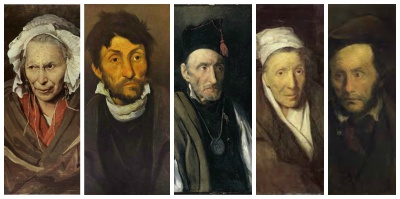Neurosis
From The Art and Popular Culture Encyclopedia

|
"Wagner est une névrose" -- Friedrich Nietzsche "If the evolution of civilization has such a far-reaching similarity with the development of an individual, and if the same methods are employed in both, would not the diagnosis be justified that many systems of civilization — or epochs of it — possibly even the whole of humanity — have become 'neurotic' under the pressure of the civilizing trends?" --Civilization and Its Discontents (1930) by Sigmund Freud, tr. James Strachey |
|
Related e |
|
Featured: |
Neurosis, also known as psychoneurosis or neurotic disorder, is a "catch all" term that refers to any mental imbalance that causes distress, but, unlike a psychosis or some personality disorders, does not prevent or affect rational thought. It is particularly associated with the field of psychoanalysis, which is one school of thought in psychology or psychiatry.
Contents |
History
Neurosis was coined by the Scottish doctor William Cullen in 1769 to refer to "disorders of sense and motion" caused by a "general affection of the nervous system". For him, it described various nervous disorders and symptoms that could not be explained physiologically. It derives from the Greek word "νεῦρον" (neuron, "nerve") with the suffix -osis (diseased or abnormal condition). The term was however most influentially defined by Carl Jung and Sigmund Freud over a century later. It has continued to be used in contemporary theoretical writing in psychology and philosophy.
The American Diagnostic and Statistical Manual of Mental Disorders (DSM) has eliminated the category of "Neurosis", reflecting a decision by the editors to provide descriptions of behavior as opposed to hidden psychological mechanisms as diagnostic criteria., and, according to The American Heritage Medical Dictionary, it is "no longer used in psychiatric diagnosis". These changes to the DSM have been controversial.
Signs and symptoms
There are many different specific forms of neurosis: pyromania, obsessive-compulsive disorder, anxiety neurosis, hysteria (in which anxiety may be discharged through a physical symptom), and a nearly endless variety of phobias. According to Dr. George Boeree, effects of neurosis can involve:
...anxiety, sadness or depression, anger, irritability, mental confusion, low sense of self-worth, etc., behavioral symptoms such as phobic avoidance, vigilance, impulsive and compulsive acts, lethargy, etc., cognitive problems such as unpleasant or disturbing thoughts, repetition of thoughts and obsession, habitual fantasizing, negativity and cynicism, etc. Interpersonally, neurosis involves dependency, aggressiveness, perfectionism, schizoid isolation, socio-culturally inappropriate behaviors, etc.
Cause
Psychoanalytical theory
As an illness, neurosis represents a variety of mental disorders in which emotional distress or unconscious conflict is expressed through various physical, physiological, and mental disturbances, which may include physical symptoms (e.g., hysteria). The definitive symptom is anxieties. Neurotic tendencies are common and may manifest themselves as depression, acute or chronic anxiety, obsessive-compulsive tendencies, specific phobias, such as social phobia, arachnophobia or any number of other phobias, and even personality disorders, such as borderline personality disorder or obsessive-compulsive personality disorder. It has perhaps been most simply defined as a "poor ability to adapt to one's environment, an inability to change one's life patterns, and the inability to develop a richer, more complex, more satisfying personality." Neurosis should not be mistaken for psychosis, which refers to loss of touch with reality, or neuroticism, a fundamental personality trait according to psychological theory.
According to psychoanalytic theory, neuroses may be rooted in ego defense mechanisms, but the two concepts are not synonymous. Defense mechanisms are a normal way of developing and maintaining a consistent sense of self (i.e., an ego), while only those thoughts and behavior patterns that produce difficulties in living should be termed "neuroses".
Jung's theory
Carl Jung found his approach particularly fitting for people who are successfully adjusted by normal social standards, but who nevertheless have issues with the meaning of their life.
I have frequently seen people become neurotic when they content themselves with inadequate or wrong answers to the questions of life (Jung, [1961] 1989:140).
The majority of my patients consisted not of believers but of those who had lost their faith (Jung, [1961] 1989:140).
[Contemporary man] is blind to the fact that, with all his rationality and efficiency, he is possessed by "powers" that are beyond his control. His gods and demons have not disappeared at all; they have merely got new names. They keep him on the run with restlessness, vague apprehensions, psychological complications, an insatiable need for pills, alcohol, tobacco, food – and, above all, a large array of neuroses. (Jung, 1964:82).
Jung found that the unconscious finds expression primarily through an individual's inferior psychological function, whether it is thinking, feeling, sensing, or intuition. The characteristic effects of a neurosis on the dominant and inferior functions are discussed in Psychological Types.
Jung saw collective neuroses in politics: "Our world is, so to speak, dissociated like a neurotic" (Jung, 1964:85).
See also
- Catastrophization
- Neuroticism
- Neurotica
- The Defeat of Baudelaire: A Psychoanalytical Study of the Neurosis of Charles Baudelaire (1931) by René Laforgue

